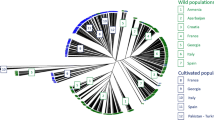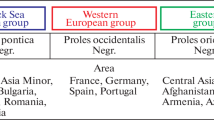Abstract.
The origin of the grapevine was investigated with archaeobotanical, cultural and historical data. A primary domestication centre was located in the Near East region but there is no agreement on the existence or role of secondary domestication centres. In this work, PCR-based microsatellite analysis has been applied to study the origin of some Italian cultivated grapevines from in situ direct domestication of the wild autoctonous grapevine. Three different Italian locations in Grosseto, Cosenza and Nuoro were identified for this study, and domesticated grapevine as well as wild local accessions growing in these location, were analysed by SSR markers. Cluster analysis performed on Cosenza and Grosseto samples showed a high value of genetic distance between domesticated and wild accessions. On the contrary two cultivars (Bovale Murru and Bovale Muristellu) recovered in Nuoro (in the Sardinia island) were very close to some wild varieties. This suggests that the latter two cultivars may have originated from wild grapevines and consequently that in this location a secondary grapevine domestication event occurred. Six Lambrusco varieties were also included in this analysis as ancient putative ancestors of the cultivated grapevines. The molecular analysis excluded this hypothesis and suggest Lambrusco as an independent Vitis taxon.



Similar content being viewed by others
References
Allison L, Lonxin Z (1999) WebPHYLIP: a web interface to PHYLIP. Bioinormatics Applications Note 15:1068–1069
Anthony F, Combes M, Astorga C, Bertrand B, Graziosi G, Lashermes P (2002) The origin of cultivated Coffea arabica L. varieties revealed by AFLP and SSR markers. Theor Appl Genet 104:894–900
Anzani R, Failla O, Scienza A, Campostrini F (1990) Wild grapevine (Vitis vinifera var. silvestris) in Italy: distribution, characteristics and germplasm preservation – 1989 report. Vitis, Special Issue:97–112
Badr A, Muller K, Schafer-Pregl R, El Rabey H, Effgen S, Ibrahim HH, Pozzi C, Rohde W, Salamini F (2000) On the origin and domestication history of barley (Hordeum vulgare). Mol Biol Evol 17:499–510
Belkhir K (1999) GENETIX, version 4.02 a windows program for population genetic analysis. Laboratoire Genome, Populations: interactions UPR 9060 du CNRS, Universite Montpellier 2, Montpellier, France
Bisson J (1999) French grapevine classed in phenotypical ecogroups assay. J Int Sci Vigne Vin 3:105–110
Bowers JE, Dangl GS, Vignani R, Meredith CP (1996) Isolation and characterisation of new polymorphic simple sequence repeat loci in grape (Vitis vinifera L.). Genome 39:628–633
Bowers JE, Dangl GS, Meredith CP (1999) Development and characterization of additional microsatellite DNA markers for grape. Am J Enol Vitic 50:243–246
Cavalli-Sforza LL, Menozzi P, Piazza A (1994) The history and geography of human genes. Princeton University Press, USA
Calo A, Scienza A, Costacurta A (2001) Vitigni d'Italia. Calderini Edagricole, Bologna, Italy
Forni G (1990) Gli albori dell'agricoltura. REDA, Roma, Italy
Fossati T, Labra M, Castiglione S, Failla O, Scienza A, Sala F (2001) The use of AFLP and SSR molecular markers to decipher homonyms and synonyms in grapevine cultivars: the case of the varietal group known as "Schiave". Theor Appl Genet 102:200–205
Heun M, Schafer-Pregl R, Klawan D, Castagna R, Accerbi M, Borghi B, Salamini F (1997) Site of einkorn wheat domestication identified by DNA fingerprinting. Science 278:1312–1314
Hopf M (1991) South and Southwest Europe. In: Van Zeist W, Wasylikowa K, Behre KE (eds) Progress in old word Palaeoethnobotany. Rotterdam-Brookfield, Balkema, pp 241–277
Kroll H (1991) Südosteuropa. In: Van Zeist W, Wasylikowa K, Behre KE (eds) Progress in old world palaeoethnobotany. Rotterdam-Brookfield, Balkema, pp 161–177
Labra M, Failla O, Fossati T, Castiglione S, Scienza A, Sala F (1999) Phylogenetic analysis of cv Ansonica growing on the island of Giglio, Italy, by AFLP and SSR markers. Vitis 38:161–166
Labra M, Winfield M, Ghiani A, Grassi F, Sala F, Scienza A, Failla O (2001a) Genetic studies on Trebbiano and morphologically related varieties by SSR and AFLP markers. Vitis 40:187–190
Labra M, Carreno-Sanchez E, Bardini M, Basso B, Sala F, Scienza A (2001b) Extraction and purification of DNA from grapevine leaves. Vitis 40:101–102
Labra M, Moriondo G, Scneider A, Grassi F, Failla O, Scienza A, Sala F (2001c) Biodiversity of grapevines (Vitis vinifera L.) grown in the Aosta valley. Vitis 41:81–92
Levadoux L (1956) Les popolation sauvages et cultivées de Vitis vinifera. Ann Amélior Plantés Cult 6:59–110
Logothetis BC (1970) The development of the vines and of viticulture in Greece, Tessalonica, Aristotelion Panepistemion Tessalonikis (in Greek with summary in French)
Lumaret R, Ouazzani N (2001) Plant genetics – ancient wild olives in Mediterranean forests. Nature 413:700–700
Nei M (1972) Genetic distance between populations. Am Natl 106:949, 283–292
Nei M (1987) Molecular evolutionary genetics. Columbia University Press, New York
Núñez DR, Walker MJ (1989) A review of paleobotanical findings of early Vitis in the Mediterranean and of the origin of cultivated grapevines, with special reference to new pointers to prehistoric exploitation in the western Mediterranean. Rev Paleobot Palynol 61:205–237
Olmo HP (1976) Grapes. In: Simmounds NW (ed) Evolution of crop plants. London, Longman, pp 294–298
Olmo HP (1995) The origin and domestication of vinifera grape. In: McGovern P, Fleming SJ, Katz SH (eds) The origin and ancient history of wine. Gordon and Breach, Luxembourg, pp 31–43
Pellerone FI, Edwads KJ, Thomas MR (2001) Grapevine microsatellite repeats: isolation characterisation and use for genotyping of grape germplasm from southern Italy. Vitis 40:179–186
Salamini F, Özkan H, Brandolini A, Shäfer-Pregl R, Martin W (2002) Genetics and geography of wild cereal domestication in the near east. Nature Review Genet 3:429–441
Scienza A, Failla O, Geuna F, Labra M (1998) Circolazione varietale antica in ambito culturale adriatico. In: L'avventura del vino nel bacino del mediterraneo. Istituto Sperimentale per la Viticultura Conegliano, Italy
Sefc KM, Lopes MS, Lefort F, Botta R, Roubelakis-Angelakis KA, Ibanez I, Pejiè HW, Wagner J, Glossl H, Steinkellner H (2000) Microsatellite variability in grapevine cultivars from different European region and evaluation of assignment testing to assess the geographic origin of cultivars. Theor Appl Genet 100:489–505
Sneath PHA, Sokal RR (1973) Numerical taxonomy. The principles and practice of numerical classification. W. H. Freeman, San Francisco, USA
Thomas M, Scott NS (1993) Microsatellite repeats in grapevine reveal DNA polymorphisms when analysed as sequenced-tagged sites (STSs). Theor Appl Genet 86:985–990
Wasilykowa KE (1991) East central Europe. In: Van Zeist W, Wasylikowa K, Behre KE (eds) Progress in old world palaeoethnobotany. Rotterdam-Brookfield, Balkema, pp 161–177
Zohary D, Spiegel-Roy P (1975) Beginnigs of fruit growing in the old world. Science 187:319–327
Zohary D, Hopf M (1993) Domestication of plants in the old world. Oxford, Clarendon Press, pp 143–150
Acknowledgements.
We are grateful to Prof. Francesco Salamini for perceptive comments that helped to improve this manuscript and anonymous referees for important comments and suggestions. This research was supported by the project "Biodiversity of the Italian grapevines and its protection from pathogens" of Fondazione Bussolera Branca, Mairano di Casteggio, Pavia, Italy. Finally, we thank Roberto Brontini and Riccardo Cop for technical support.
Author information
Authors and Affiliations
Corresponding author
Additional information
Communicated by F. Salamini
The first two authors contributed equally to this research
Rights and permissions
About this article
Cite this article
Grassi, F., Labra, M., Imazio, S. et al. Evidence of a secondary grapevine domestication centre detected by SSR analysis. Theor Appl Genet 107, 1315–1320 (2003). https://doi.org/10.1007/s00122-003-1321-1
Received:
Accepted:
Published:
Issue Date:
DOI: https://doi.org/10.1007/s00122-003-1321-1




